Application of Shore Sediments Accumulated in Navigation Channel for Restoration of Sandy Beaches around Pärnu City, SW Estonia, Baltic Sea
Abstract
:1. Introduction
2. Materials and Methods
2.1. Information about Study Site and Earlier Works
2.2. Methods
3. Results and Discussion
3.1. Sediment Budget
3.2. Assessing Scenarios for Beach Nourishment at Pärnu–Valgeranna Site
3.3. Waves and Sediment Transport in Valgeranna
4. Conclusions and Suggestions
Author Contributions
Funding
Institutional Review Board Statement
Informed Consent Statement
Data Availability Statement
Acknowledgments
Conflicts of Interest
References
- Orviku, K. Rannad ja Rannikud; TLÜ kirjastus: Tallinn, Estonia, 2018; p. 349, (In Estonian with English summary). [Google Scholar]
- HELCOM. Guidelines for Management of Dredged Material at Sea; Adopted by HELCOM 36-2015 on 4 March 2015 and Amended by HELCOM 41-2020 on 4 March 2020; 2020; pp. 1–39. Available online: https://helcom.fi/wp-content/uploads/2019/08/HELCOM-Reporting-Format-for-Management-of-Dredged-Material-at-Sea_2016.xlsx (accessed on 1 September 2023).
- Tiede, J.; Jordan, C.; Moghimi, A.; Schlurmann, T. Long-term shoreline changes at large spatial scales at the Baltic Sea: Remote-sensing based assessment and potential drivers. Front. Mar. Sci. 2023, 10, 1207524. [Google Scholar] [CrossRef]
- Różyński, G.; Bielecka, M. Sediment quality in the Polish part of the trans-boundary Vistula Lagoon: Implications for deposition management. Mar. Policy 2022, 146, 105288. [Google Scholar] [CrossRef]
- Karaliūnas, V.; Jarmalavičius, D.; Pupienis, D.; Janušaitė, R.; Žilinskas, G.; Karlonienė, D. Shore Nourishment Impact on Coastal Landscape Transformation: An Example of the Lithuanian Baltic Sea Coast. J. Coast. Res. 2020, 95, 840–844. [Google Scholar] [CrossRef]
- Hojan, M.; Rurek, M.; Krupa, A. The Impact of Sea Shore Protection on Aeolian Processes Using the Example of the Beach in Rowy, N Poland. Geosciences 2019, 9, 179. [Google Scholar] [CrossRef]
- Schernewski, G.; Knotz, S. Beach Nourishment as a Successful Measure against Erosion, Rostock—DE; Sistermans, P., Nieuwenhuis, O., Eds.; Eurosion Case Study; DHV Group: Rostock, Germany, 2015; pp. 1–4. [Google Scholar]
- Pupienis, D.; Jonuškaite, S.; Jarmalavičius, D.; Žilinskas, G. Klaipeda port jetties impact on the Baltic Sea shoreline dynamics, Lithuania. J. Coast. Res. 2013, 65, 2167–2172. [Google Scholar] [CrossRef]
- Pinto, C.A.; Mendes Silveira, T.; Teixeira, S.B. Beach nourishment practice in mainland Portugal (1950–2017): Overview and retrospective. Ocean Coast. Manag. 2020, 192, 105211. [Google Scholar] [CrossRef]
- Hanley, M.E.; Hoggart, S.P.G.; Simmonds, D.J.; Bichot, A.; Colangelo, M.A.; Bozzeda, F.; Heurtefeux, H.; Ondiviela, B.; Ostrowski, R.; Recio, M.; et al. Shifting sands? Coastal protection by sand banks, beaches and dunes. Coast. Eng. 2014, 87, 136–146. [Google Scholar] [CrossRef]
- Hamm, L.; Capobianco, M.; Dette, H.H.; Lechuga, A.; Spanhoff, R.; Stive, M.J.F. A summary of European experience with shore nourishment. Coast. Eng. 2002, 47, 237–264. [Google Scholar] [CrossRef]
- Hanson, H.; Brampton, A.; Capobianco, M.; Dette, H.H.; Hamm, L.; Laustrup, C.; Lechuga, A.; Spanhoff, R. Beach nourishment projects, practices, and objectives—A European overview. Coast. Eng. 2002, 47, 81–111. [Google Scholar] [CrossRef]
- Palginõmm, V.; Orviku, K.; Suursaar, Ü.; Kont, A.; Tõnisson, H.; Rivis, R. Lessons Learned from Record-High Storm Surges and Associated Inundations in Pärnu, SW Estonia. J. Coast. Res. 2018, 85, 1391–1395. [Google Scholar] [CrossRef]
- Tõnisson, H.; Kont, A.; Orviku, K.; Suursaar, Ü.; Rivis, R.; Palginõmm, V. Application of system approach framework for coastal zone management in Parnu, SW Estonia. J. Coast. Conserv. 2019, 23, 931–942. [Google Scholar] [CrossRef]
- Hang, T.; Kohv, M. Glacial varves at Pärnu, southwestern Estonia: A local varve chronology and proglacial sedimentary environment. GFF 2013, 135, 273–281. [Google Scholar] [CrossRef]
- Suursaar, Ü.; Kall, T. Decomposition of Relative Sea Level Variations at Tide Gauges Using Results from Four Estonian Precise Levelings and Uplift Models. IEEE J. Sel. Top. Appl. Earth Obs. Remote Sens. 2018, 11, 1966–1974. [Google Scholar] [CrossRef]
- Suursaar, Ü.; Sooäär, J. Decadal variations in mean and extreme sea level values along the Estonian coast of the Baltic Sea. Tellus Ser. A-Dyn. Meteorol. Oceanogr. 2007, 59, 249–260. [Google Scholar] [CrossRef]
- Jaagus, J.; Suursaar, Ü. Long-term storminess and sea level variations on the Estonian coast of the Baltic Sea in relation to large\scale atmospheric circulation. Est. J. Earth Sci. 2013, 62, 73–92. [Google Scholar] [CrossRef]
- BACC. Second Assessment of Climate Change for the Baltic Sea Basin; Springer: Heidelberg, Germany; New York, NY, USA; Dordrecht, The Netherlands; London, UK, 2015. [Google Scholar]
- Kont, A.; Tõnisson, H.; Jaagus, J.; Suursaar, Ü.; Rivis, R. Eesti randade areng viimastel aastakümnetel kliima ja rannikumere hüdrodünaamiliste muutuste tagajärjel. In 30 aastat keskkonnaökoloogiat. Ökoloogia keskus 1992–2022; Terasmaa, J., Truus, L., Kont, A., Eds.; Tallinna Ülikooli ökoloogia instituudi/keskuse publikatsioonid: Tallinn, Estonia, 2022; Volume 13, pp. 9–58. (In Estonian) [Google Scholar]
- Kartau, K. Valgeranna ja Pärnu vahelise randla areng. Master’s Thesis, Tallinn University of Technology, Tallinn, Estonia, 2011. (In Estonian). [Google Scholar]
- Last, W.M. Mineralogical analysis of lake sediments. Track. Environ. Change Using Lake Sediments 2001, 2, 143–187. [Google Scholar] [CrossRef]
- Heiri, O.; Lotter, A.F.; Lemcke, M.-J. Loss on ignition as a method for estimating organic and carbonate content in sediments: Reproducibility and comparability of results. J. Paleolimnol. 2001, 25, 101–110. [Google Scholar] [CrossRef]
- Alari, V.; Björkqvist, J.V.; Kaldvee, V.; Mölder, K.; Rikka, S.; Kask-Korb, A.; Vahter, K.; Pärt, S.; Vidjajev, N.; Tõnisson, H. LainePoiss®—A Lightweight and Ice-Resistant Wave Buoy. J. Atmos. Ocean. Technol. 2022, 39, 573–594. [Google Scholar] [CrossRef]
- Booij, N.; Ris, R.C.; Holthuijsen, L.H. A third-generation wave model for coastal regions: 1. Model description and validation. J. Geophys. Res. 1999, 104, 7649–7666. [Google Scholar] [CrossRef]
- Tõnisson, H.; Suursaar, Ü.; Rivis, R.; Kont, A.; Orviku, K. Observation and analysis of coastal changes in the West Estonian Archipelago caused by storm Ulli (Emil) in January 2012. J. Coast. Res. 2013, 65, 832–837. [Google Scholar] [CrossRef]
- Tõnisson, H.; Suursaar, Ü.; Alari, V.; Muru, M.; Rivis, R.; Kont, A.; Viitak, M. Measurement and Model Simulations of Hydrodynamic Parameters, Observations of Coastal Changes and Experiments with Indicator Sediments to Analyse the Impact of Storm St. Jude in October, 2013. J. Coast. Res. 2016, 75, 1257–1261. [Google Scholar] [CrossRef]
- Van der Wal, D. Aeolian Transport of Nourishment Sand in Beach-Dune Environments; University of Amsterdam: Amsterdam, The Netherlands, 1999; pp. 1–157. [Google Scholar]
- Pupienis, D.; Jarmalavičius, D.; Žilinskas, G.; Fedorovič, J. Beach nourishment experiment in Palanga, Lithuania. J. Coast. Res. 2014, 70, 490–495. [Google Scholar] [CrossRef]
- Jarmalavičius, D.; Žilinskas, G.; Pupienis, D.; Karaliūnas, V.; Janušaitė, R. Natural and human control of the coastal development, Baltic Sea, Lithuania. Geogr. Metraštis 2020, 5, 3–12, (In Lithuanian with English summary). [Google Scholar] [CrossRef]
- Tõnisson, H.; Männikus, R.; Vaasma, T.; Vandel, E.; Kont, A.; Alari, V.; Suuroja, S.; Eelsalu, M.; Vilumaa, K.; Palginõmm, V.; et al. Metoodika Väljatöötamine Laevateedele Kuhjuvate Rannasetete Mahu ja Kvaliteedi Määramiseks Ning Kasutamiseks Randade taastamisel Pärnu Sadama ja Seda Ümbritsevate Randade Näitel; Report; Institute of Ecology, Tallinn University: Tallinn, Estonia, 2023; p. 174. (In Estonian) [Google Scholar]
- USACE. Coastal Engineering Manual; Manual No. 1110-2-1100; Department of the Army, U.S. Army Corps of Engineers: Washington, DC, USA, 2008. [Google Scholar]
- Brand, E.; Ramaekers, G.; Lodder, Q. Dutch experience with sand nourishments for dynamic coastline conservation—An operational overview. Ocean Coast. Manag. 2022, 217, 106008. [Google Scholar] [CrossRef]
- Bosboom, J.; Stive, M.J.F. Coastal Dynamics I; Delft Academic Press: Delft, The Netherlands, 2015. [Google Scholar]
- Najafzadeh, F.; Jankowski, M.; Giudici, A.; Männikus, R.; Suursaar, Ü.; Soomere, T.; Viška, M. Spatiotemporal variability of wave climate in the Gulf of Riga. Oceanologia 2023, in press. [CrossRef]
- Männikus, R.; Soomere, T.; Kudryavtseva, N. Identification of mechanisms that drive water level extremes from in situ measurements in the Gulf of Riga during 1961–2017. Cont. Shelf Res. 2019, 182, 22–36. [Google Scholar] [CrossRef]



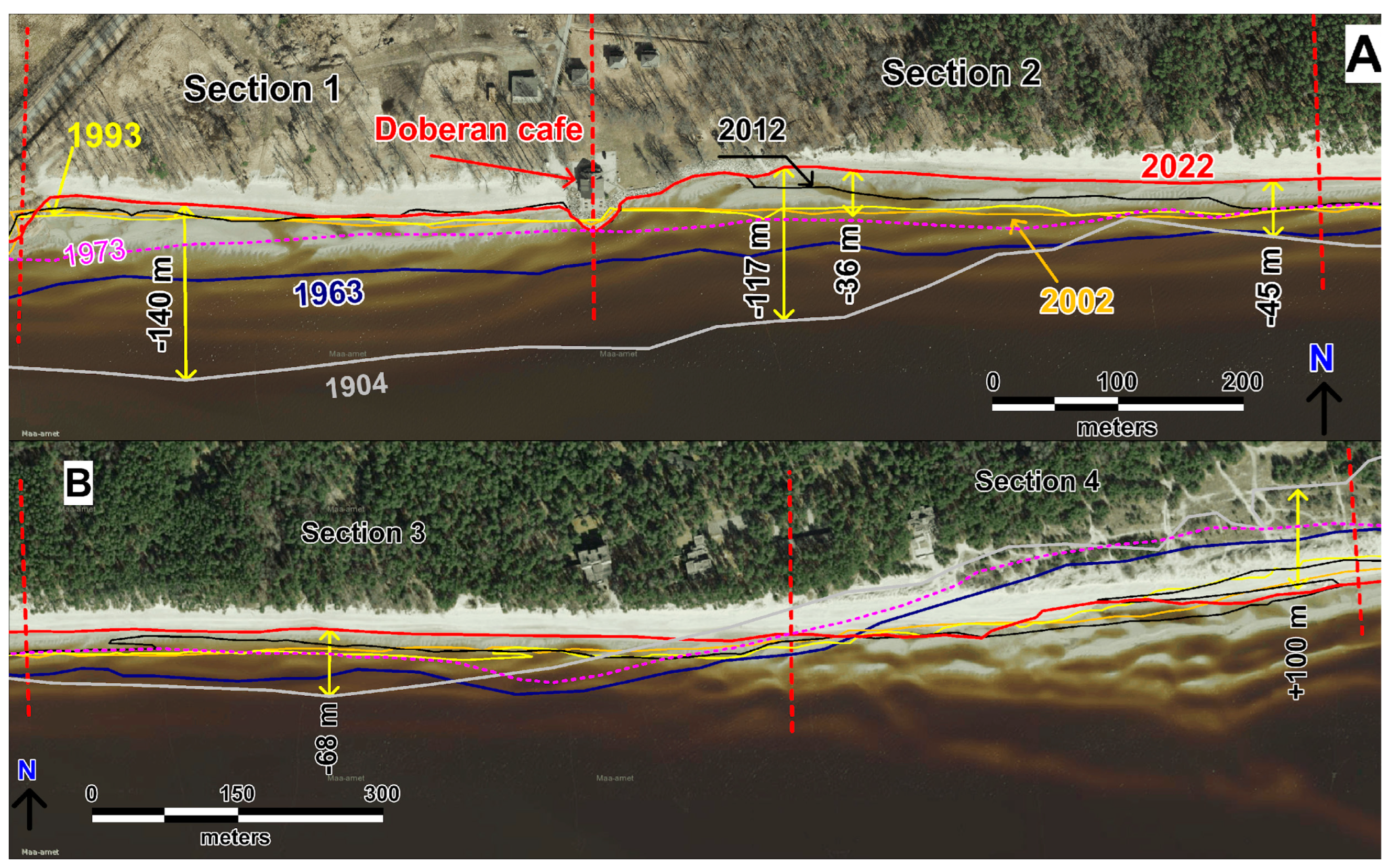
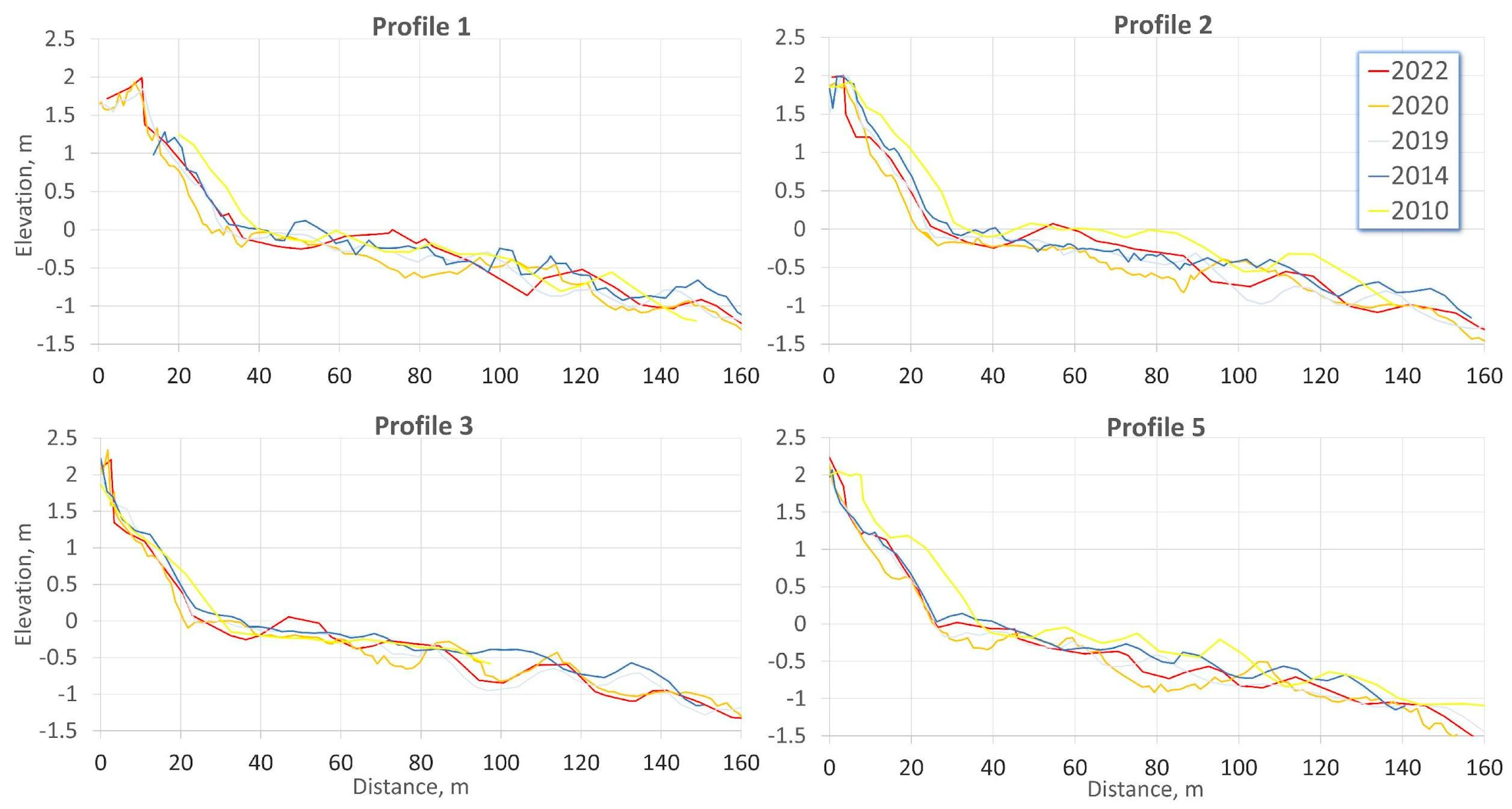
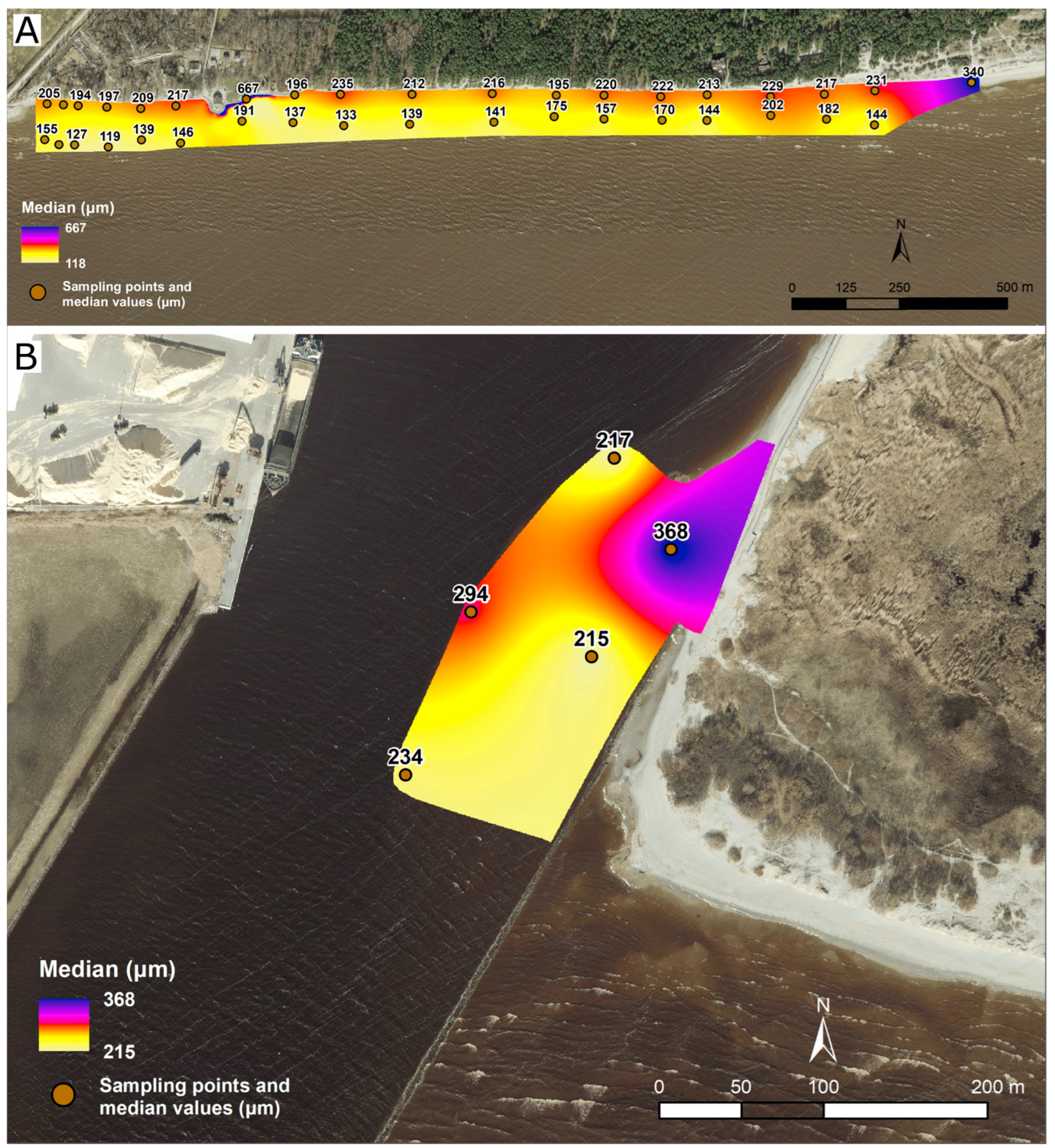

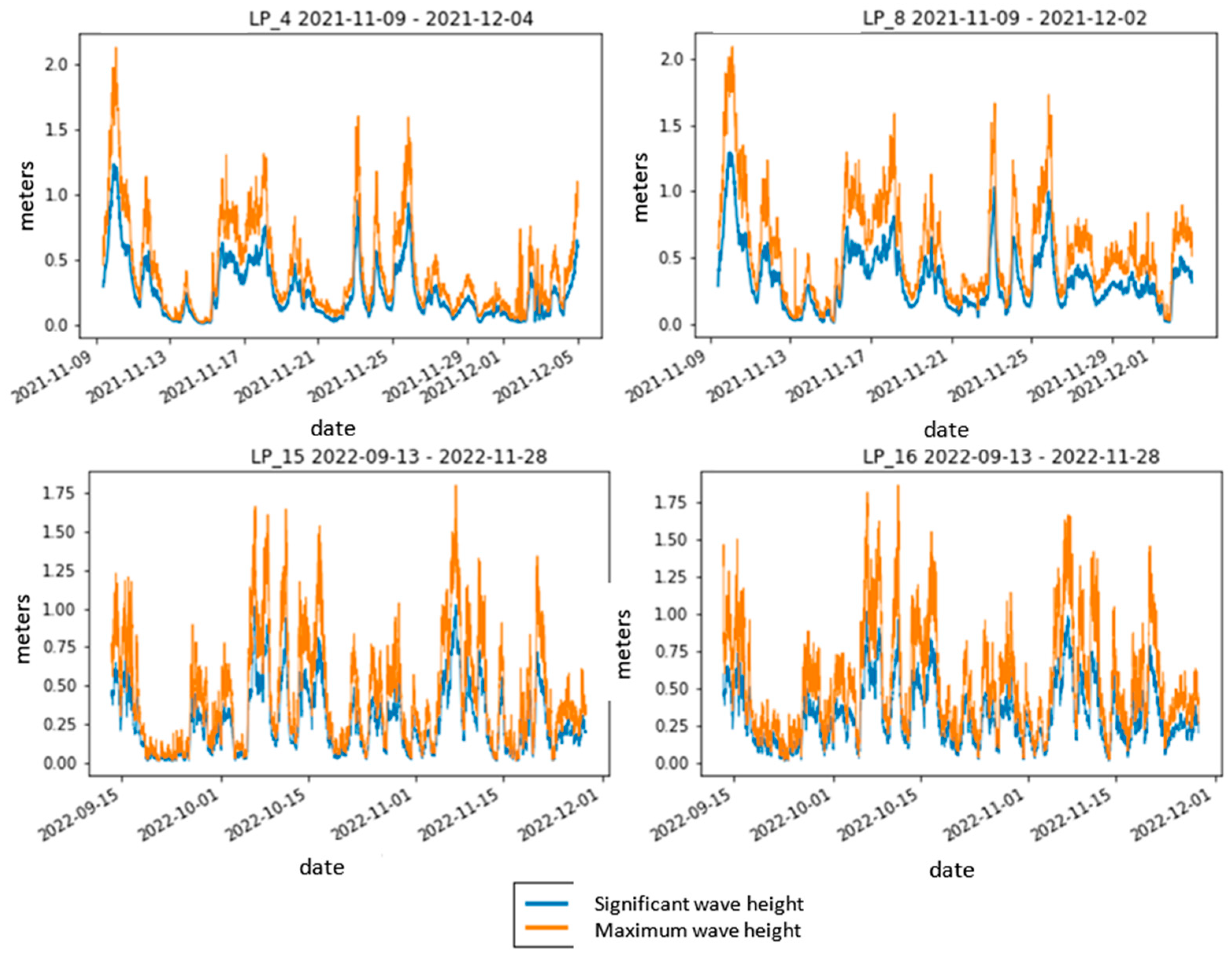
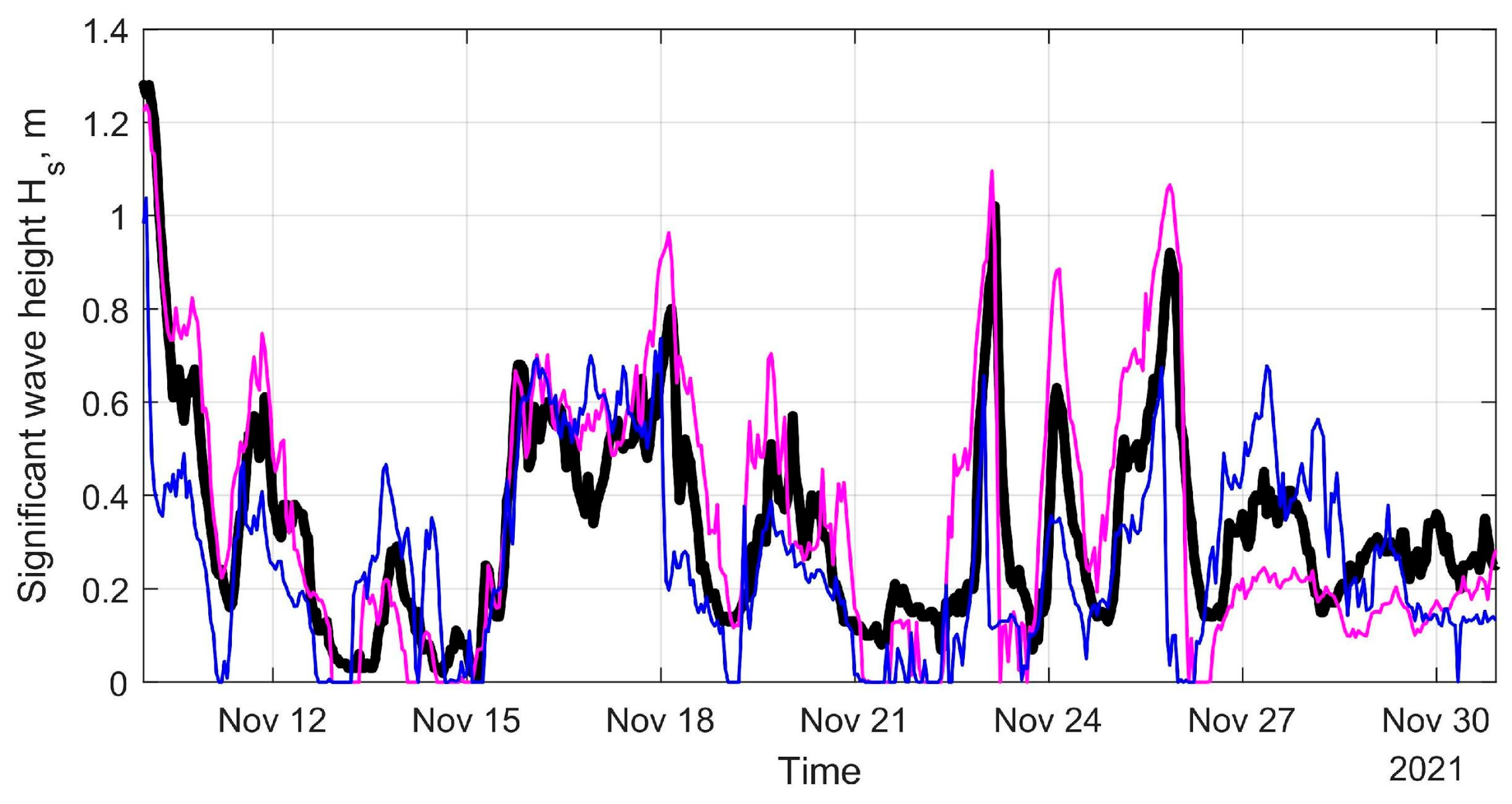
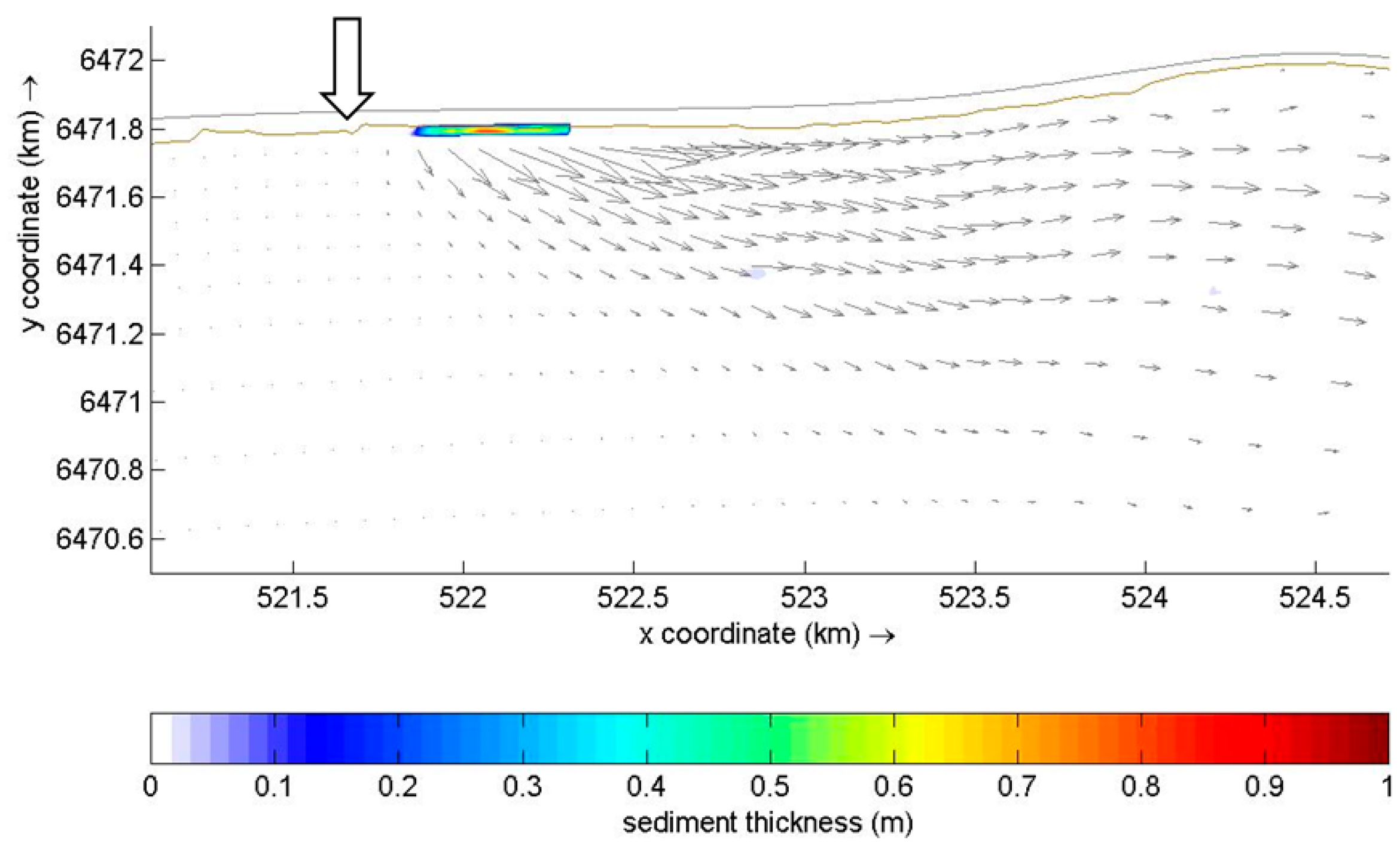


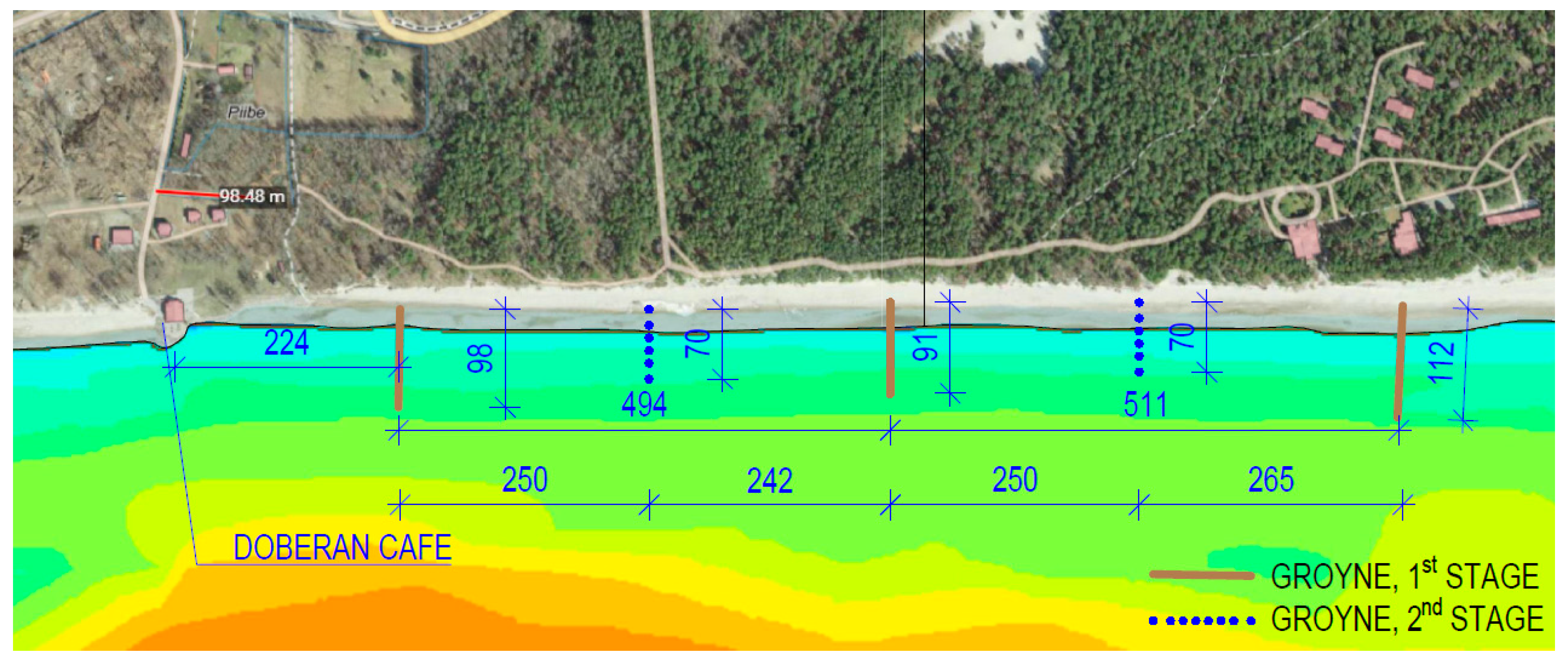
| Period | Section 1 455–0 (m) | Section 2 0–565 (m) | Section 3 565–1345 (m) | Section 4 1345–1935 (m) | Section 5 1935–2565 (m) |
|---|---|---|---|---|---|
| 1903–2022 | −1.02 | −0.65 | −0.31 | 0.57 | 1.37 |
| 1963–2022 | −0.89 | −0.89 | −0.74 | 0.67 | 0.54 |
| 1973–2022 | −0.51 | −0.66 | −0.50 | 1.07 | 0.80 |
| 1993–2022 | −0.28 | −0.86 | −0.66 | 0.16 | 1.07 |
| 2002–2022 | −0.43 | −1.35 | −0.76 | −0.06 | 1.24 |
| 2012–2022 | −0.34 | −1.33 | −1.30 | −0.48 | 1.55 |
| Method for 30,000 m3 | Time (24 h Days) | Cost (EUR) | EUR/m3 |
|---|---|---|---|
| Watermaster, pumping (500 m) + road transport | 52–80 | 191,608 | 6.89 |
| Dredging vessel | 5–7 | 175,000 | 5.83 |
| Road transport | 10 | 152,612 | 5.09 |
| No. | Percentile | Hours in a Year | Wind Speed at Kihnu, m/s | Water Level at Pärnu, m | Hours in a Year Divided by 240 h | Occurrence of Simulation Results in Years |
|---|---|---|---|---|---|---|
| 1 | 70% | 958.3 | 8.9 | 0.49 | 3.99 | 0.25 |
| 2 | 90% | 319.4 | 11.4 | 0.75 | 1.33 | 0.75 |
| 3 | 95 | 159.7 | 12.6 | 0.88 | 0.67 | 1.50 |
| 4 | 99% | 31.9 | 15.0 | 1.21 | 0.13 | 7.51 |
| 5 | 99.75% | 8.0 | 17.0 | 1.46 | 0.03 | 30.05 |
| 6 | 99.9% | 3.2 | 18.4 | 1.60 | 0.01 | 75.13 |
| No. | Description of Layout Scenarios |
|---|---|
| 03x | Southwestern wind. Nourishment in the east, thickness 1 m. No coastal protection structures. |
| 11x | Southwestern wind. Nourishment in the east, thickness 1 m. Groyne length 200 m, the longest and the easternmost 500 m. |
| 13x | Southwestern wind. Nourishment in the east, thickness 1 m. 8 groynes, length 110 m, spacing 230 m. |
| 14x | Southwestern wind. Nourishment in the east, thickness 1 m. 4 groynes in the shallow water, length 100 m, distance 500 m. |
| 15x | Southwestern wind. Nourishment in the west, thickness 1 m. 4 detached breakwaters with length of 200 m, spacing 200 m, 100 m south from the coastline. |
| 23x | Southwestern wind. Nourishment in the west, thickness 1 m. 5 groynes, length 110 m, spacing 230 m. |
| 30x | Southwestern wind. Nourishment in the shallow sea, in the south, thickness 1 m. No coastal structures. |
| 33x | Southwestern wind. Nourishment in the shallow sea, in the south, thickness 1 m. 8 groynes, length 110 m, spacing 230 m. |
| No. | Percentiles, SW Winds | Layouts | Occurrence of Simulation Results in Years | |||||||
|---|---|---|---|---|---|---|---|---|---|---|
| 03x | 11x | 13x | 14x | 15x | 23x | 30x | 33x | |||
| 1 | 70 | −4% | −1% | −1% | −4% | −2% | 0% | 0% | 0% | 0.25 |
| 2 | 90 | −31% | −14% | −19% | −24% | −21% | −8% | −7% | −8% | 0.75 |
| 3 | 95 | −51% | −24% | −27% | −35% | −29% | −17% | −15% | −17% | 1.50 |
| 4 | 99 | −80% | −42% | −42% | −50% | −44% | −44% | −47% | −51% | 7.51 |
| 5 | 99.75 | −99% | −65% | −60% | −68% | −61% | −77% | −85% | −90% | 30.05 |
| 6 | 99.9 | −100% | −75% | −63% | −90% | −64% | −85% | −100% | −100% | 75.13 |
Disclaimer/Publisher’s Note: The statements, opinions and data contained in all publications are solely those of the individual author(s) and contributor(s) and not of MDPI and/or the editor(s). MDPI and/or the editor(s) disclaim responsibility for any injury to people or property resulting from any ideas, methods, instructions or products referred to in the content. |
© 2024 by the authors. Licensee MDPI, Basel, Switzerland. This article is an open access article distributed under the terms and conditions of the Creative Commons Attribution (CC BY) license (https://creativecommons.org/licenses/by/4.0/).
Share and Cite
Tõnisson, H.; Männikus, R.; Kont, A.; Palginõmm, V.; Alari, V.; Suuroja, S.; Vaasma, T.; Vilumaa, K. Application of Shore Sediments Accumulated in Navigation Channel for Restoration of Sandy Beaches around Pärnu City, SW Estonia, Baltic Sea. J. Mar. Sci. Eng. 2024, 12, 394. https://doi.org/10.3390/jmse12030394
Tõnisson H, Männikus R, Kont A, Palginõmm V, Alari V, Suuroja S, Vaasma T, Vilumaa K. Application of Shore Sediments Accumulated in Navigation Channel for Restoration of Sandy Beaches around Pärnu City, SW Estonia, Baltic Sea. Journal of Marine Science and Engineering. 2024; 12(3):394. https://doi.org/10.3390/jmse12030394
Chicago/Turabian StyleTõnisson, Hannes, Rain Männikus, Are Kont, Valdeko Palginõmm, Victor Alari, Sten Suuroja, Tiit Vaasma, and Kadri Vilumaa. 2024. "Application of Shore Sediments Accumulated in Navigation Channel for Restoration of Sandy Beaches around Pärnu City, SW Estonia, Baltic Sea" Journal of Marine Science and Engineering 12, no. 3: 394. https://doi.org/10.3390/jmse12030394





